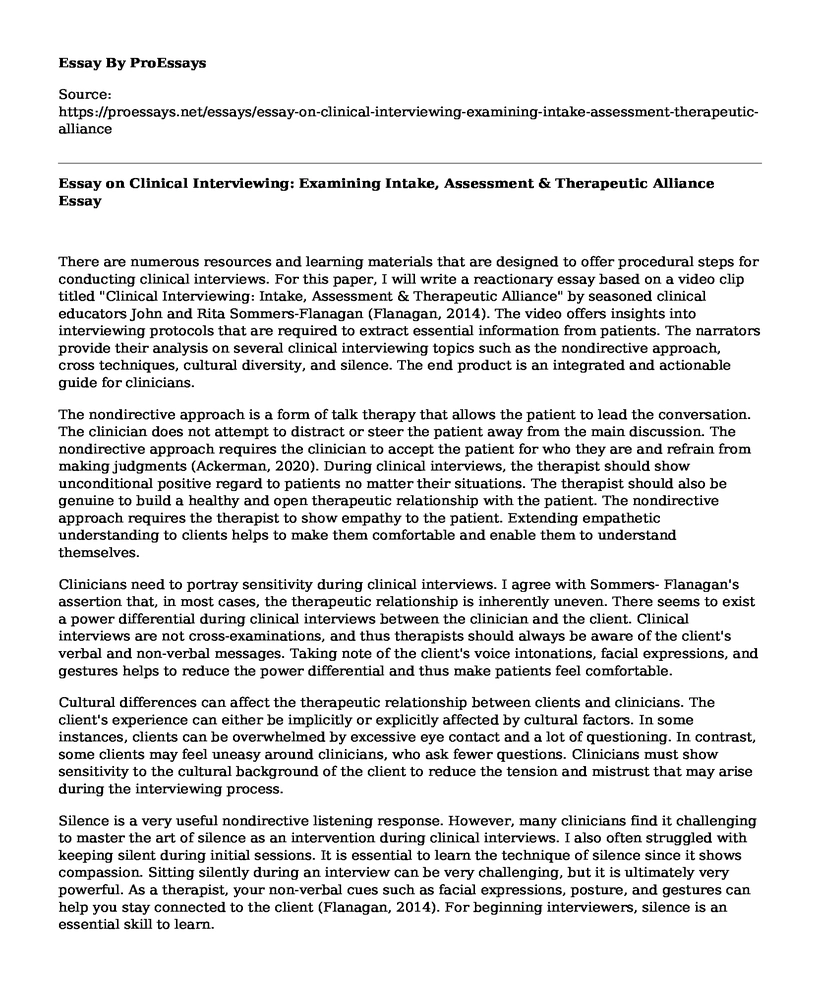There are numerous resources and learning materials that are designed to offer procedural steps for conducting clinical interviews. For this paper, I will write a reactionary essay based on a video clip titled "Clinical Interviewing: Intake, Assessment & Therapeutic Alliance" by seasoned clinical educators John and Rita Sommers-Flanagan (Flanagan, 2014). The video offers insights into interviewing protocols that are required to extract essential information from patients. The narrators provide their analysis on several clinical interviewing topics such as the nondirective approach, cross techniques, cultural diversity, and silence. The end product is an integrated and actionable guide for clinicians.
The nondirective approach is a form of talk therapy that allows the patient to lead the conversation. The clinician does not attempt to distract or steer the patient away from the main discussion. The nondirective approach requires the clinician to accept the patient for who they are and refrain from making judgments (Ackerman, 2020). During clinical interviews, the therapist should show unconditional positive regard to patients no matter their situations. The therapist should also be genuine to build a healthy and open therapeutic relationship with the patient. The nondirective approach requires the therapist to show empathy to the patient. Extending empathetic understanding to clients helps to make them comfortable and enable them to understand themselves.
Clinicians need to portray sensitivity during clinical interviews. I agree with Sommers- Flanagan's assertion that, in most cases, the therapeutic relationship is inherently uneven. There seems to exist a power differential during clinical interviews between the clinician and the client. Clinical interviews are not cross-examinations, and thus therapists should always be aware of the client's verbal and non-verbal messages. Taking note of the client's voice intonations, facial expressions, and gestures helps to reduce the power differential and thus make patients feel comfortable.
Cultural differences can affect the therapeutic relationship between clients and clinicians. The client's experience can either be implicitly or explicitly affected by cultural factors. In some instances, clients can be overwhelmed by excessive eye contact and a lot of questioning. In contrast, some clients may feel uneasy around clinicians, who ask fewer questions. Clinicians must show sensitivity to the cultural background of the client to reduce the tension and mistrust that may arise during the interviewing process.
Silence is a very useful nondirective listening response. However, many clinicians find it challenging to master the art of silence as an intervention during clinical interviews. I also often struggled with keeping silent during initial sessions. It is essential to learn the technique of silence since it shows compassion. Sitting silently during an interview can be very challenging, but it is ultimately very powerful. As a therapist, your non-verbal cues such as facial expressions, posture, and gestures can help you stay connected to the client (Flanagan, 2014). For beginning interviewers, silence is an essential skill to learn.
Conclusion
In conclusion, Clinical interviewing techniques are an essential skill set when carrying out practice in a clinic setting. It is, however, unfortunate that many clinicians are poorly equipped to handle clinical interviews. Nurses have to keenly assess their patients to establish what's wrong with them and find out their illnesses. Clinicians require to have a good grasp of clinical interviewing skills to enable them to diagnose and devise a treatment for their patients. A skilled clinical interviewer is thus able to achieve a defined purpose within a stipulated duration.
References
Ackerman, C. (2020). 10 Person-Centered Therapy Techniques Inspired by Carl Rogers [+PDF]. Retrieved from https://positivepsychology.com/client-centered-therapy/
Flanagan, J. & Flanagan, R. (2014). Clinical Interviewing: Intake, Assessment & Therapeutic Alliance. (Institutional/Instructor's version). Video available at www.psychotherapy.net
Cite this page
Essay on Clinical Interviewing: Examining Intake, Assessment & Therapeutic Alliance. (2023, Mar 28). Retrieved from https://proessays.net/essays/essay-on-clinical-interviewing-examining-intake-assessment-therapeutic-alliance
If you are the original author of this essay and no longer wish to have it published on the ProEssays website, please click below to request its removal:
- Health of Older Adults
- The Gerontological Explosion Essay
- Argumentative Essay Sample on Bacterial Pathobionts in the Pathogenesis of Inflammatory Bowel Disease
- Jan's Chronic or Acute Pain - Essay Sample
- Disability in Higher Education: The Self-Identification Challenge- Essay Sample
- Essay Example on Marine Pollution: Impact on Biodiversity and Public Health
- Paper Example on Healthcare Professionals: Code of Ethics for Optimal Performance







